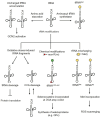Stress response regulation of mRNA translation: Implications for antioxidant enzyme expression in cancer
- PMID: 39495917
- PMCID: PMC11572934
- DOI: 10.1073/pnas.2317846121
Stress response regulation of mRNA translation: Implications for antioxidant enzyme expression in cancer
Abstract
From tumorigenesis to advanced metastatic stages, tumor cells encounter stress, ranging from limited nutrient and oxygen supply within the tumor microenvironment to extrinsic and intrinsic oxidative stress. Thus, tumor cells seize regulatory pathways to rapidly adapt to distinct physiologic conditions to promote cellular survival, including manipulation of mRNA translation. While it is now well established that metastatic tumor cells must up-regulate their antioxidant capacity to effectively spread and that regulation of antioxidant enzymes is imperative to disease progression, relatively few studies have assessed how translation and the hijacking of RNA systems contribute to antioxidant responses of tumors. Here, we review the major stress signaling pathways involved in translational regulation and discuss how these are affected by oxidative stress to promote prosurvival changes that manipulate antioxidant enzyme expression. We describe how tumors elicit these adaptive responses and detail how stress-induced translation can be regulated by kinases, RNA-binding proteins, RNA species, and RNA modification systems. We also highlight opportunities for further studies focused on the role of mRNA translation and RNA systems in the regulation of antioxidant enzyme expression, which may be of particular importance in the context of metastatic progression and therapeutic resistance.
Keywords: Antioxidant; Cancer; RNA.
Conflict of interest statement
Competing interests statement:T.J.B. is co-founder and holds equity in Codomax (Worcester, MA).
Figures



References
-
- Ishii T., et al. , Transcription factor Nrf2 coordinately regulates a group of oxidative stress-inducible genes in macrophages. J. Biol. Chem. 275, 16023–16029 (2000). - PubMed
-
- Fabbri L., Chakraborty A., Robert C., Vagner S., The plasticity of mRNA translation during cancer progression and therapy resistance. Nat. Rev. Cancer 21, 558–577 (2021). - PubMed
Publication types
MeSH terms
Substances
Grants and funding
LinkOut - more resources
Full Text Sources
Medical

